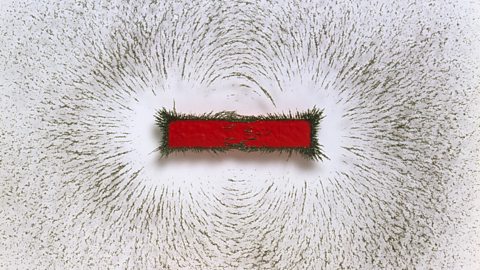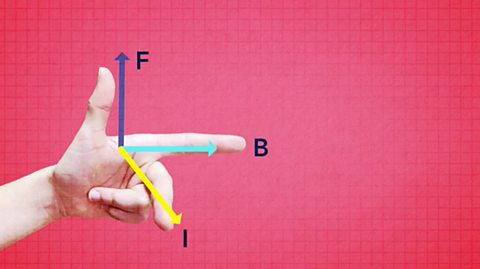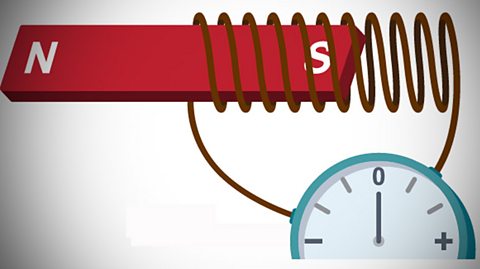What are the key learning points about transformers?
Transformers come in two types;
step-up transformers increase the voltageThe potential difference across a cell, electrical supply or electrical component. It is measured in volts (V). (and decrease the current)
step-down transformers decrease the voltage.
Transformers consist of a primary coil, secondary coil and an iron core.
The output voltage depends on the number of turns on the secondary coil compared to the primary coil.
The input and output voltages are both alternating.
Transformers have an efficiencyThe fraction of the energy supplied to a device which is transferred in a useful form. of 1 (100%), so electrical power input is the same as electrical power output.
The turns-ratio equation can be used to calculate the output voltage: \(\frac{N_s}{N_p} = \frac{V_s}{V_p}\)
How do transformers work?
There are two types of transformer:
A step-up transformerA transformer that increases the voltage of the ac supply. which increases or steps-up voltage.
A step-down transformerA transformer that decreases the voltage of the ac supply. which reduces or steps-down voltage.
A basic transformer is made from two coils of wire:
A primary coil connected to an alternating currentAlternating current occurs when electric charges continually change direction whilst moving through a conductor. Mains AC supply alternates with a frequency of 50Hz.(a.c) supply.
A secondary coil leading to the alternating current (AC) output.
The coils are wound around an iron core.
They are magnetically connected but not electrically connected.
When a transformer is working:
A primary voltage drives an alternating currentAlternating current occurs when electric charges continually change direction whilst moving through a conductor. Mains AC supply alternates with a frequency of 50Hz. through the primary coil.
The primary coil current produces a changing magnetic fieldA region around a magnet or around a wire carrying a current, where a magnetic force is experienced.. This magnetic field changes as the current changes.
The iron core is easily magnetised and carries the changing magnetic field from the primary coil to link the secondary coil.
Alternating voltage is induced in the secondary coil.
The induced voltage causes an alternating current to flow.
Key points
Transformers can only work with alternating current.
Input and output voltages and currents are both alternating (AC).
Mains voltage is AC and not DC so that transformers can be used.
The size of the output voltage depends on the number of turns on the secondary compared to the primary coil.
A step-up transformer, which steps-up voltage, has more turns in the secondary than in the primary.
A step-down transformer, which steps-down voltage, has fewer turns in the secondary than in the primary.
The transformer in the diagram above is a step-down transformer – there are fewer turns on the secondary coil than on the primary coil.
| Type of transformer | Size of output voltage | Number of turns on the secondary compared to the primary |
|---|---|---|
| Step-up | Increased | More |
| Step-down | Decreased | Fewer |
Question
The primary coil of a transformer has 1,000 turns.
What type of transformerAn electrical device that increases, or decreases, the potential difference (voltage) of an alternating current. is it if the secondary coil has 500 turns?
Answer
The secondary coil has fewer turns than the primary coil and so this is a step-down transformer.
It will step-down voltage.
How to calculate the voltage of a transformer (Higher tier only)
The ratioA ratio compares two or more quantities by using parts of a whole, eg a ratio of 1 : 5 means that for every 1 of the parts on the left, there are 5 of the parts on the right. of voltages on the transformerAn electrical device that increases, or decreases, the potential difference (voltage) of an alternating current. coils equals the ratio of the numbers of turns on the coils.
The equation can be used to calculate what the output voltage might be from a particular transformer, or to work out how to design a transformer to make a particular voltage change.
\(\frac{secondary~voltage}{primary~voltage} = \frac{number~of~turns~on~secondary}{number~of~turns~on~primary}\)
\(\frac{V_s}{V_p} = \frac{N_s}{N_p}\)
Vp = voltage across the primary coil in volts, V (the input voltage).
Vs = voltage across the secondary coil in volts, V (the output voltage).
Np = the number of turns on the primary coil.
Ns = the number of turns on the secondary coil.
In a step-up transformer, VS is GREATER THAN VP.
In a step-down transformer, Vs is LESS THAN Vp.
Question
A 230 V, a.c. transformer, has 11,500 turns on its primary coil and 600 turns on its secondary coil.
Calculate the voltage obtained from the secondary coil.
Answer
\(\frac{V_s}{V_p} = \frac{N_s}{N_p}\)
Vp = 230 V
Np = 11,500
Ns = 600
\(\frac{V_s}{230} = \frac{600}{11,500}\)
Vs = 12 V
The output voltage from the secondary coil is 12 V.
This is an example of a step-down transformer.
There are fewer turns on the secondary coil, and there is a smaller voltage across the secondary coil.
Voltage has been stepped-down.
How to calculate transformer power transfer
Electric power can be calculated using the equation:
Electric power = voltage V × current I
P = VI
Where:
P = electric power in watts, W
V = voltage in volts, V
I = current in amperes, A
Assuming that a transformer is 100% efficient, the following equation can be used to calculate the power output from the transformer:
Input power = output power
VsIs = VpIp
Question
A step-down transformer converts 11,500 V into 230 V.
The power output is used to run a 2000 W kettle.
Calculate the current flowing in the primary coil.
Input power = output power
Output power = 2000 W
Input power = VpIp</sub
Vp = 11,500 V
11,500 v Ip = 2000
Ip = \(\frac{2000}{11,500}\)
Ip = 0.17 A
The current flowing in the primary coil is 0.17 A.
What do transformers do in the transmission of electricity?
Electricity is distributed from power stations to consumers through the National Grid, which allows distant power stations to be used.
It also allows a mix of different energy resources to be used efficiently to supply the country’s electricity, whatever the local demand.
The National Grid ensures a reliable supply of electricity.
If one power station breaks down, the grid will continue to supply electricity from other power stations in the grid.
The National Grid also responds to the demand for electricity – supplying more at peak times.
What are the main features of the National Grid?
The diagram below shows the main features of the National Grid.
The greater the current in a cable, the greater the heat loss to the surroundings.
This means that high currents waste more energy than low currents.
Why use high voltage?
When a transformer steps up voltage, current is stepped down.
A step-up transformer at the power station steps up the voltage and consequently steps down the current.
This means that the current flowing in the overhead cables is relatively small and can be distributed long distances across country.
Transmitting small current greatly reduces heat lost in the cables, which in turn reduces the number of power stations needed.
The main features of the Grid are:
Power station which generates electricity at 25,000 V.
A step-up transformerA transformer that increases the voltage of the ac supply. beside the power station to step-up the voltage and consequently step-down the current reducing electrical energy wasted as heat energy in the overhead cables. Electricity is sent through these at 400,000 V.
A step-down transformerA transformer that decreases the voltage of the ac supply. close to domestic consumers to step the voltage down to 230 V for safe use in the home
Question
A power station produces 3 × 109 W of power with a current of 4 × 104
Calculate the voltage produced.
Answer
Electric power = VI
Power = 3 × 109 W
I = 4 × 104 A
\(\frac{{3}\times{10}^9{~W}}{{4}\times{10}^4{~A}}\)
V = 75,000 V
The voltage generated by the power station is 75,000 V or 75 kV
How to stay safe when near power lines
High voltage overhead power cables are very dangerous.
The cables are supported high above the general public on pylons.
However, electricity can kill even if you do not touch the line itself.
The voltage levels are so high that accidents can occur several meters from the power line.
It is important that nobody or anything is too close to a power line.
Pylons and transformers are not playgrounds or climbing frames.
Do not play with kites near power lines.
Do not use an outdoor trampoline near power lines.
Do not fish near power lines.
Never refuel a vehicle or machine closer than 60 meters from a power line.
Test your knowledge
More on Unit 2: Magnetism and electromagnetism
Find out more by working through a topic
- count1 of 4

- count2 of 4

- count3 of 4
